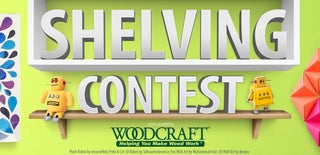Introduction: Rustic Dry Goods Shelf
I needed a way to hold and display our dry goods in mason and Weck jars. The old system of had a couple milk crates turned on their side, and just wasn't cutting it. I went for a rustic look by using reclaimed barn siding and salvaged hardwood flooring. With this shelf I now have plenty of room to store the rice, beans, corn meal, and occasional butternut squash.
This was a fairly simple project that requires a drill, table saw, planer, and miter saw. Of course this can all be done with hand tools as well if that's your thing.
Read on to see how I put it all together!
Step 1: Prep Material and Layout Height
One of the constraints of working with reclaimed or salvaged wood is your're often limited to what's on hand. There's no getting second piece that will match perfectly. For me this means the shelves vary in depth from the bottom at 8", middle two are 7", and top is only 5".
The width was determined by my wall where I had two light switches present. I gave two inches of clearance around the plates which left a 45" span for the shelves.
All boards were lightly planed to bring the faces fairly smooth but still keeping the defects present in the reclaimed wood. All edges squared up on the table and miter saw.
I find by laying out the boards with some of the actual jars I can find the best spacing. What looked proportional came out to 36" tall, and as a sanity check I mocked it up with chalk in it's final placement.
My design intent is to have some of our pans hanging below the shelves so I made to sure give them enough clearance but still keep the top shelf accessible.
Step 2: Assemble the Sides
The sides were made from salvaged hardwood flooring, and by utilizing the existing tongue and groove it makes assembly really easy. Three boards give enough width, and I found enough long planks to keep the outer rails one solid piece. After gluing together I trimmed off the unused tongue and groove for clean edges.
Offcuts from the horizontal shelves were used as cleats on the side panels. A decorative chamfer was cut on each cleat and then was glued and screwed based on the spacing determined earlier. Make sure to drill the through and pilot holes along with countersink to keep everything from splitting.
Some may have chosen to use a joinery method that would hide the fasteners, but I liked the look of the square drive screws so I left them exposed.
A quick check against my layout confirms we're ready to assemble.
Step 3: Assemble the Shelf!
The horizontal shelves are glued and screwed to the cleats. The cleats keep everything spaced vertically, but I needed some extra clamps to hold everything square for the first few shelves.
Once again the screws are left exposed, but you barely notice them when the shelf is filled.
Step 4: Apply a Finish
I really love the soft look of Tung oil on rustic pieces. The oil really highlights some of sawmill marks and the patina is gorgeous. Two coats was sufficient. I'm mostly looking for the color.
Step 5: Add Rails and Attach to Wall
A 3/4" piece of hardwood serves as a horizontal wall cleat that runs the lengh of the top shelf. Before installing to the wall, I clamped it to the shelf and pre-drilled all my pilot and through holes. The cleat was then mounted to the wall with plastic anchors and #10 brass screws. Screws attach the shelf to the wall cleat in the previously drilled holes.
I added a 3/4" rail out of the hardwood flooring along the front of the shelves to keep jars from walking off.
Step 6: Hang the Pans and Fill the Shelf
I installed simple hook hangers (the same color as the screws of course) but used a hacksaw to cut off the tapered threaded portion of the screw. This will give the maximum engagement of threads in the ~3/4" shelf, without having a sharp point stick out the top.
I've been really happy with how the shelves turned out, they're a huge improvement over the old milk crates.
Now everything is nice and visible and I'm more likely to make recipes from scratch!

Participated in the
Shelving Contest













